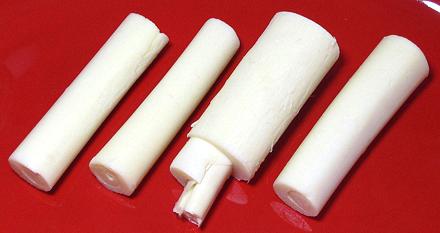 [Palmito (Spanish); Coeurs de Palmier (French); Palm Cabbage; mainly
Guilielma gasipae but also Euterpe edulis]
[Palmito (Spanish); Coeurs de Palmier (French); Palm Cabbage; mainly
Guilielma gasipae but also Euterpe edulis]
These are the leaf buds of palm trees. They may be a couple of feet long and are generally cut into lengths that fit in a can or jar. Harvesting the heart kills the whole palm stem, so commercial production is from clumping palms, either Açai (Euterpe oleracea) or far more widely Peach Palms which take a lot less water to grow. These palms just sprout new stems from the base. The photo specimens ranged from 0.7 inches to 1.3 inches diameter and 3-5/8 inches long (from a 14 ounce can, they'd be cut slightly longer for a 28 ounce can).
More on Palm Products.
Hearts of palm are firm and a little fibrous on the outside, tapering to soft in the center layers. The large piece in the photo above has two layers pushed out to show the structure. Flavor is mild and pleasant, but wouldn't be that big a deal without the appearance and texture.
While France is still the largest importer, hearts of palm are becoming popular in the US for salads and appetizers. Most imported into the US are from Peach Palms grown in Costa Rica. and Ecuador. At one time most palm hearts sold in North America were from the cabbage palm, which has a cabbage shaped heart, but harvesting these kills the tree. The expense of replacing the trees resulted in the name "millionaire's salad" for this form.